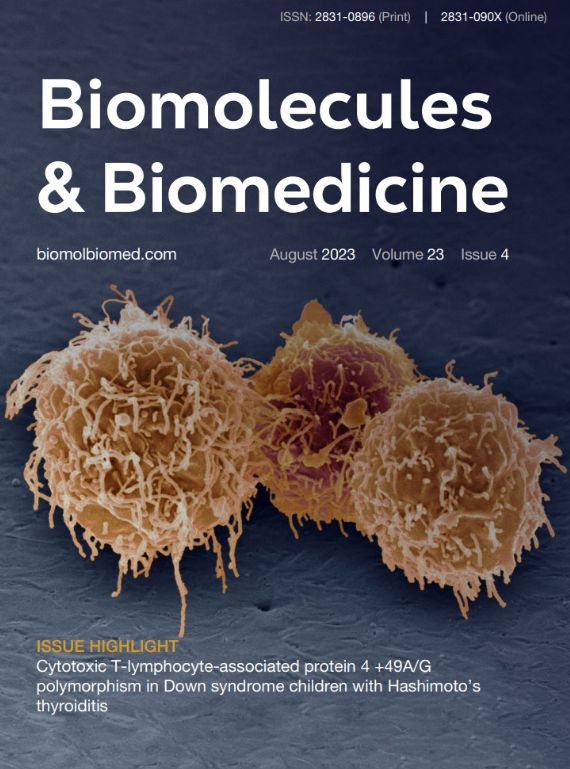Vol.23 No.2
Published: 11.07.2023.
Authors in this issue:
Abdella M Habib, Abdul-Badi Abou-Samra, Aleksandra Aracki Trenkić, Angela Pia Cazzolla, Atalla Hammouda, Benjie Xu, Boris Zec, Cheng Rao, Chenwei Li, Chunyue Feng, Dan Li, Dejan Nesic, Domenico Ciavarella, Dominik Vilímek, Dragan Stojanov, Eleonora Lo Muzio, Elina Beleva, Fang Li, Fei Liu, Feng Wang, Francesca Di Serio, Francesca Spirito, Gaofei Cao, Gordana Petrovic, Haibo Lu, Hao Jiang, Haowen Pang, Hongbing Ma, Hua Yang, Ivanka Nenova, Jan Malůš, Jaroslav Uchytil, Jianguang Shi, Jiayue Shao, Jie Gong, Jie Lian, Jieqiu Zhang, Jieyun Huang, Jin Li, Jun Wang, Justin Clark, Kai Sun, Lichun Wei, Lina Zhao, Ling-Yu Long, Lishuang Wang, Liu Shi, Lorenzo Lo Muzio, Lucia Varraso, Luigi Santacroce, Luka Nikolic, Marek Bužga, Maria Pepe, Mario Dioguardi, Matej Pekař, Mei Shi, Mengyao Zhang, Michele Di Cosola, Milica Radovanović, Milica Živanović, Miroslav Mišić, Mohan Dong, Moustapha Hamdi, Nan Xu, Omran A H Musa, Pavol Holéczy, Petr Kutáč, Qian Jiang, Qian Zhang, Qiong Qing, Quan-Bing Zhang, Ren Wang, Renato Contino, Roberto Lovero, Rui Zhang, Run Zhang, Saif Badran, Sanja Ninic, Sara Alharami, Sasa Popovic, Semir Vranic, Sergej Prijic, Shigao Huang, Shuli Tang, Siqi Liu, Snezana Ristic, Snezhana Stoencheva, Srdjan Pasic, Stasa Krasic, Suhail A Doi, Tanya Deneva, Veronika Horká, Vito Crincoli, Vladislav Vukomanovic, Vuk Milošević, Vukota Radovanović, Weijie Wu, Weiwei Li, Wen-Min Chen, Wudong Wang, Xiangyi Pang, Xiao-Jun Huang, Xiaopeng Yao, Xiaoxiao Liu, Xin Wang, Xinjian Li, Xu Wang, Xuejing Zhong, Ya-Zhen Qin, Yanhui Chen, Ying Zhang, Yingying Jin, Yongrong Zhang, Yuchen Wang, Yun Zhou, Zdeněk Švagera, Zhanet Grudeva-Popova, Zhenjing Jin, Zishan Wang,
Edited by:
Muzafer Mujic & Semir Vranic
Author guidelines
Editorial Policy
4
Issues23
ArticlesYour first address
𝐁𝐢𝐨𝐦𝐨𝐥𝐞𝐜𝐮𝐥𝐞𝐬 𝐚𝐧𝐝 𝐁𝐢𝐨𝐦𝐞𝐝𝐢𝐜𝐢𝐧𝐞 (formerly 𝐁𝐉𝐁𝐌𝐒) is the first address for discoveries in the field of biomedical research.
Become guest editor
Special Issues are led by Guest Editors who are experts in the subject and oversee the editorial process for papers.
Editor’s choice articles
The aim is to provide a snapshot of some of the most exciting work published in the various research areas of the journal.
Archive
See all
Volume 23, Issue 2, 2023
Volume 23, Issue 2, 2023
Volume 15, Issue 1,
Volume 14, Issue 1,
- All Sections
- Biochemistry
- Molecular Biology
- Pathology
- Anatomy
- Translational and Clinical Research
- New and Emerging Medical Entities
16.03.2023.
Research article
Analysis of cardiac manifestation and treatment of multisystem inflammatory syndrome in children related to SARS-CoV-2
Cardiovascular (CV) manifestations are common (35%–100%) in the multisystem inflammatory syndrome in children. Our study aimed to analyze treatment impact and CV involvement in patients with multisystem inflammatory syndrome in children. The retrospective cohort included 81 patients treated between April 2020 and December 2021 (9.3 ± 4.6 years). Elevated cardiac troponin I and pro-B-type natriuretic peptide were observed in 34.2% and 88.5% of patients, respectively. Myocardial dysfunction was observed in 50.6%. Children older than 10 years had a 4-fold increased risk of myocardial dysfunction (odds ratio [OR] 3.6, 95% confidence interval [CI] 1.4–8.9; p ═ 0.006). A moderate negative correlation was proved between left ventricular ejection fraction and C-reactive protein (rr ═ −0.48; p < 0.001). More than one-fifth of the patients presented with shock. Coronary artery dilatation was observed in 6.2% of patients. Mild pericardial effusion was detected in 27.1% of children. On standard electrocardiogram, 52.6% of children had negative T waves in the inferior and/or precordial leads; transient QTc prolongation was registered in 43% of patients. Treatment failure was observed in 19 patients. Patients initially treated with intravenous immunoglobulins had 10-fold higher chances for treatment failure than patients treated with corticosteroids (OR 10.6, 95% CI 3.18–35.35; p < 0.001). CV manifestations were observed in more than half of the patients, with acute myocardial dysfunction being the most common, especially in children older than 10 years. We established a negative association between the degree of elevation of inflammatory markers and left ventricular ejection fraction. Patients treated with intravenous immunoglobulins who had CV manifestations had treatment failures more frequently than patients treated with corticosteroids.
Stasa Krasic, Sanja Ninic, Sergej Prijic, Sasa Popovic, Srdjan Pasic, Gordana Petrovic, Boris Zec, Snezana Ristic, Dejan Nesic, Luka Nikolic, Vladislav Vukomanovic
16.03.2023.
Research article
Evaluation of qualitative and quantitative taste alterations in COVID-19
Angela Pia Cazzolla, Roberto Lovero, Francesca Spirito, Michele Di Cosola, Luigi Santacroce, Eleonora Lo Muzio, Domenico Ciavarella, Mario Dioguardi, Vito Crincoli, Maria Pepe, Lucia Varraso, Renato Contino, Francesca Di Serio, Lorenzo Lo Muzio











